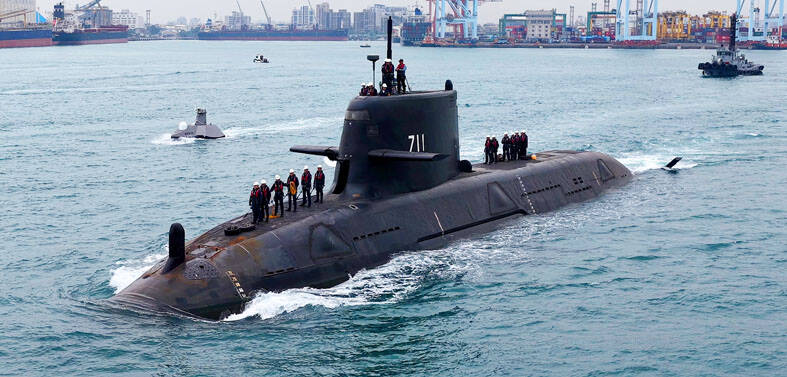Academia Sinica geoscience researchers yesterday unveiled a study that used GPS data to track the nation’s crustal changes following the 921 Earthquake in 1999, to shed more light on the creation of mountains and seismic cycles.
The magnitude 7.3 earthquake occurred on Sept. 21, 1999, in Nantou County’s Jiji Township (集集), leaving 2,456 people dead and destroying thousands of buildings.
Subterranean rocks at a depth of 20km had stabilized one year after the quake, but deeper layers might be still changing very slowly today, Academia Sinica Institute of Earth Sciences researcher Hsu Ya-ju (許雅儒) said.

Photo: Chien Hui-ju, Taipei Times
While GPS data has been used to study fault lines in previous studies, the team developed a new method of using such data to model geographical changes from the Earth’s surface to subterranean layers 50km in depth without having to make a lot of hypotheses, she said.
The study extends from a master’s thesis written by Tang Chi-hsien (唐啟賢) in 2016, when he was studying at National Central University, Hsu said.
Tang, 27, is serving alternative military service by doing research at the institute and plans to return to National Taiwan University to complete his doctoral degree.
Hsu and Tang worked with University of Southern California professor Sylvain Barbot and Nanyang Technological University professor James Moore to study GPS data about crustal changes collected over 14 years following the quake.
Taiwan has many mountains higher than 3,000m, but it is not yet clear how they arose from the Earth’s crust and the team’s study could offer some clues, Tang said.
Tang grew up in Hualien, where earthquakes are frequent, and that motivated him to research seismic activity, he said.
The team detailed their findings in a paper titled “Lower-crustal rheology and thermal gradient in the Taiwan orogenic belt illuminated by the 1999 Chi-Chi earthquake” which was published in the journal Science Advances.
The team’s findings are also useful for other nations, as rock strata in different nations share common features, institute director Chung Sun-lin (鍾孫霖) said.
To commemorate the 20th anniversary of the 921 Earthquake, the Taiwan Earthquake Research Center is to hold an international conference in September, Chung added.

US climber Alex Honnold is to attempt to scale Taipei 101 without a rope and harness in a live Netflix special on Jan. 24, the streaming platform announced on Wednesday. Accounting for the time difference, the two-hour broadcast of Honnold’s climb, called Skyscraper Live, is to air on Jan. 23 in the US, Netflix said in a statement. Honnold, 40, was the first person ever to free solo climb the 900m El Capitan rock formation in Yosemite National Park — a feat that was recorded and later made into the 2018 documentary film Free Solo. Netflix previewed Skyscraper Live in October, after videos

NUMBERS IMBALANCE: More than 4 million Taiwanese have visited China this year, while only about half a million Chinese have visited here Beijing has yet to respond to Taiwan’s requests for negotiation over matters related to the recovery of cross-strait tourism, the Tourism Administration said yesterday. Taiwan’s tourism authority issued the statement after Chinese-language daily the China Times reported yesterday that the government’s policy of banning group tours to China does not stop Taiwanese from visiting the country. As of October, more than 4.2 million had traveled to China this year, exceeding last year. Beijing estimated the number of Taiwanese tourists in China could reach 4.5 million this year. By contrast, only 500,000 Chinese tourists are expected in Taiwan, the report said. The report

Temperatures are forecast to drop steadily as a continental cold air mass moves across Taiwan, with some areas also likely to see heavy rainfall, the Central Weather Administration (CWA) said. From today through early tomorrow, a cold air mass would keep temperatures low across central and northern Taiwan, and the eastern half of Taiwan proper, with isolated brief showers forecast along Keelung’s north coast, Taipei and New Taipei City’s mountainous areas and eastern Taiwan, it said. Lows of 11°C to 15°C are forecast in central and northern Taiwan, Yilan County, and the outlying Kinmen and Lienchiang (Matsu) counties, and 14°C to 17°C

STEERING FAILURE: The first boat of its class is experiencing teething issues as it readies for acceptance by the navy, according to a recent story about rudder failure The Hai Kun (海鯤), the nation’s first locally built submarine, allegedly suffered a total failure of stern hydraulic systems during the second round of sea acceptance trials on June 26, and sailors were forced to manually operate the X-rudder to turn the submarine and return to port, news Web site Mirror Daily reported yesterday. The report said that tugboats following the Hai Kun assisted the submarine in avoiding collisions with other ships due to the X-rudder malfunctioning. At the time of the report, the submarine had completed its trials and was scheduled to begin diving and surfacing tests in shallow areas. The X-rudder,